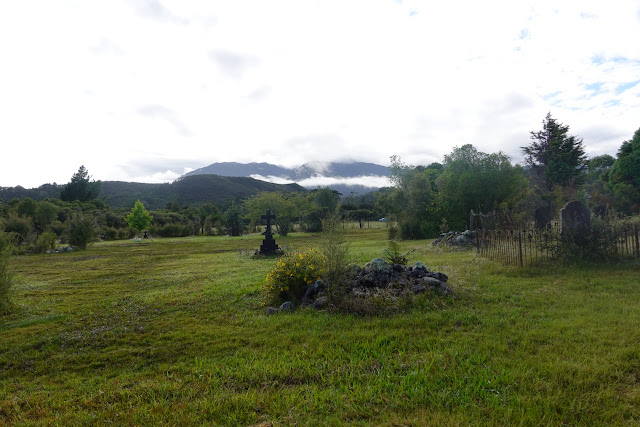Several related Burke and Flynn families left Derrycraff in Aghagower Parish, Co Mayo, around the time of the Famine, and ended up settling in/near Perth in Scotland. We don't presently know whether they left because of starvation and extreme hardship, or whether they were evicted from their land.
Recently my third cousin Maggie Gaffney visited the Perth area, and made a visit to Wellshill Cemetery to see the grave of our mutual 3x-great-grandparents, Michael Burke and Bridget Flynn. She had made a previous visit, and had given me a copy of a photo of their headstone.
This stone marks the burial place of Michael Burke and his wife Bridget, whose maiden surname of Flynn is used on the stone, and of their daughter Mary. Mary is found on the 1861 census as a child aged 9, the only member of the family listed at 134 High St Perth who was born in Perthshire, Perth, rather than in Ireland. At the base of this headstone you can vaguely read the name of John, who died in New Zealand. He was the son of Michael and Bridget, and brother of Martin Burke, my 2x-great-grandfather. John is buried in the Darfield Catholic Cemetery in New Zealand, alongside his sister-in-law Ann Burke née Philp, and his niece Mary Burke, the eldest daughter of Martin and Ann.
When Maggie sent me the above headstone photo, she also sent me another photo from a slight distance, that gave an overview of the position of the headstone in the cemetery. There was another headstone quite close to 'our' one, but I never gave it much thought.
On Maggie's recent return visit to this cemetery, she took some time to clear the earth from the base of our 3x-grt-grandparents' headstone so you could read John's details more clearly. She also sent me a close-up photo that had both headstones. On the adjoining headstone, the name was Judy Flynn. Flynn is quite a common name in Ireland, but the proximity of these two stones had me querying whether there was a FAN relationship going on here, ie Friends, Associates and Neighbours. Could the Flynns in neighbouring graves be connected somehow? Judy was not a name I had ever heard of in our family, but it seemed it was worth exploring the possibility.On this headstone Judy Flynn was listed as being 58 years old when she died in 1861, so it would seem she was born around 1803. The second name on the headstone was Ann Mulroy who died in 1908. This raised questions about whether Mulroy might be Judy's married name, and whether Ann could perhaps be Judy's child.
As it turned out it was surprisingly easy to get an initial answer to my query about whether Bridget and Judy Flynn were related. There was help on Ancestry, as several people are clearly researching the Milroy/Mulroy family, and someone had put a death registration for Judy on her profile.
It became immediately obvious that Judy and Bridget were most likely to be sisters. We know that Bridget's parents were Patrick Flynn and Mary Flynn née Derrick/Derrig, and these names were listed as parents for Judy. We also know that Bridget had a brother called Peter Flynn who had come to Perth, and the informant for Judy's death was a Peter Flynn, who was described as her brother, present at her death.
Clearly at some stage more research will be needed to uncover more links and confirmation. From the trees on Ancestry, it seems as if the Milroy descendants don't know about Judy's nephew Martin Burke who came to New Zealand. Contacting them is on my list of things to do. Meanwhile, I am just glad I thought of pursuing the possibility of a FAN relationship, even if the neighbours concerned were in a graveyard.
Thanks to Maggie Gaffney for sharing the headstone photos with me, and for thus sparking off this whole FAN investigation!

























